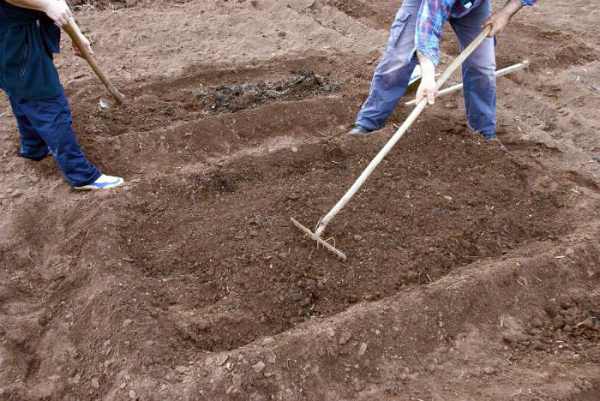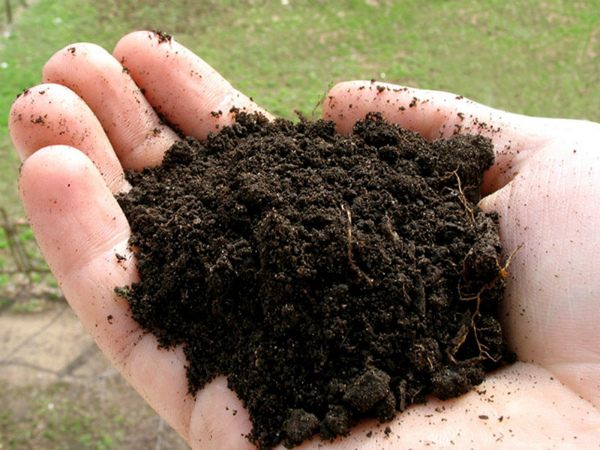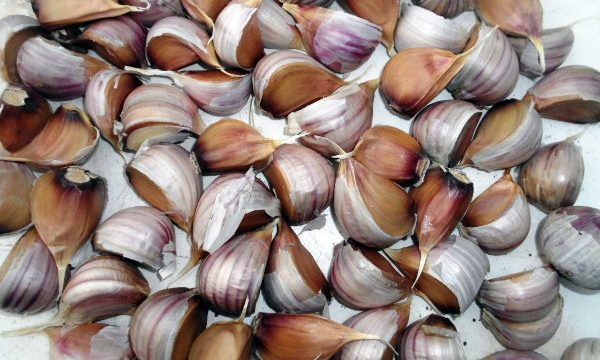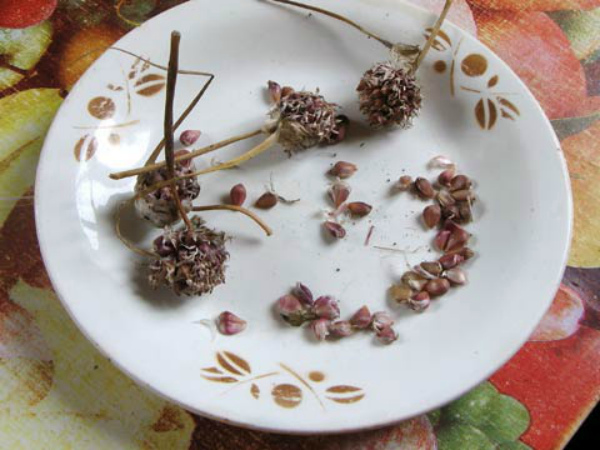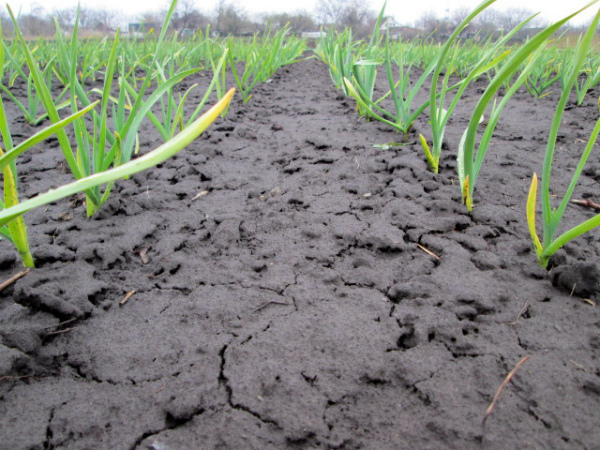Secrets of the correct planting of garlic in the garden
The planting process is divided into three stages of equal importance: preparation of the soil, planting material and planting the garlic itself.
Content
Soil preparation
Preparing the soil in the garden is one of the important elements, because the set of mineral and organic elements affects the development of the root system of the plant, the size and quality of its bulb. When choosing a place in the garden, give preference to an open, dry, well-lit place. It is very good if water does not accumulate there, as this will ruin the bulbs.
The soil composition should be rich in organic macro- and microelements. It is best to plant garlic in a bed with loamy soil and neutral acidity (pH 6.5-7.0). If the acidity of the soil is increased, carry out liming with slaked lime or dolomite flour.
Preparatory work in the garden should be carried out in the fall, one and a half to two months before planting. If you are planting winter garlic, you can thoroughly fertilize the soil when planting the predecessor crop. However, if you chose spring spring garlic, then you will have to additionally fertilize the area in the fall, after the garden has been cleared of plant residues and disinfected.
For feeding per 1 square meter, you will need: 1 bucket of organic fertilizer (mullein, horse manure), 1 tablespoon of superphosphate and potassium fertilizer. For acidic soil, add 1 cup dolomite flour or hydrated lime to this mixture. They dig up the area on the bayonet of the shovel, that is, 18-20 centimeters deep in order to saturate the soil well. Then it is necessary to level the bed so that there are no lumps and the ground is level. Based on the same proportion, mix a solution of copper sulfate (40 grams per 10 liters of water) and pour it over the area. Cover the bed with plastic wrap or roofing felt.
An important nuance in preparing the soil is what has grown in this place before. So, you should not send garlic for planting after garlic, onions, late-ripening potatoes, turnips, carrots. The fact is that they contribute to the accumulation of toxins and microelements harmful to garlic, and also attract pests that will spoil the growing bulbs.
Try to plant garlic in the garden after cucumbers, cauliflower, early ripe white cabbage, legumes and melons, tomatoes. They saturate the soil with useful fertilizers as much as possible, so you just have to consolidate the result.
Garlic preparation
In order for the spring season to start favorably and the garlic to grow out of the ground, the seed should be selected correctly. However, not everything is so simple, long before planting, the teeth must be carefully looked after and properly stored. These two points are essential for garlic to grow large and healthy.
Store teeth or unassembled heads in a cool, dry place. The room temperature should not exceed +7 ° C and the relative humidity should be zero.You can store the seed at a temperature of about 15-17 ° C, but in this case, one and a half months before planting, it must be placed in a cool environment with a temperature of between -3 ° C and + 2 ° C. This will help awaken vegetative processes, bring the cloves of garlic to a state of turgor and help them form a developed root system.
The day before planting the garlic on the garden bed, it is necessary to bring the cloves into a room with room temperature and disinfect. For this, a light pink solution of potassium permanganate, a solution of copper sulfate or ash liquor is used. In the case of the first two solutions, the cloves need to be soaked for a day, but you can keep them in ash liquor only for 2 hours. You can rinse the inoculum in a solution of the drug (optional) "Fundazol", "Epin". This treatment also stimulates the growth of the garlic.
To get a bountiful harvest, you need to plant only healthy, large cloves. In spring garlic, it is better to choose the cloves from the outer circle, since they are larger than the central ones and are better protected by the husk. Examine each tooth carefully for mold, rot, dents, wormholes. Garlic is planted only with healthy, undamaged seeds. Care for future bulbs at the stage of preparation for planting also consists in peeling and separating the "bottom" of each clove, so as not to hinder the emergence and development of roots.
How to plant
Planting garlic should be carried out when the ground in the garden warms up to at least +7 ° C (in the case of planting spring garlic). On a pre-fertilized and dug up bed, grooves are outlined in which the cloves will be planted. However, depending on the type and variety of crops, garlic can be planted in different ways, based on your wishes, capabilities and efforts that you are willing to spend on caring for the plant.
Planting methods
If you plan to plant garlic separately from other crops in the garden, you can outline several rows, between which there will be 20-25 centimeters of free space, while there should be at least 10 centimeters between the cloves. This arrangement will prevent the garlic leaves from shading each other. The cloves are planted to a depth of 5 to 15 centimeters, depending on the variety and type of seed (cloves or air bulbs).
If you do not have a lot of space in the garden, you can plant the garlic in two tiers: the first at a depth of 9-10 centimeters, the second at a depth of 5-6 centimeters. In this case, the garden must be watered and mulched well.
When planting together, for example, with strawberries or carrots, you can use two layout options. In the first case, the garlic is located between the beds with another plant. Thus, crops do not interfere with each other's development, but at the same time they protect against various pests. In the second case, the plants are staggered, that is, they alternate on the same bed.
In any case, it is possible to plant in this way only by observing the prescribed distance between the seedlings - at least 10 centimeters, so that the plants do not interfere with each other's development.
Care
Depending on the variety and variety of garlic that is planted in the garden, the care for it differs. Winter garlic should not be watered for the winter and the first months of spring heat, since the ground is sufficiently moistened with melting snow. Before sprouting, it is worth watering the spring garlic abundantly, the water that you used when planting in the garden is not enough for it.
When the warm weather takes hold, that is, starting from late April - early May, planting care includes regular watering. However, keep in mind that the ground should be moistened, but should not turn into an artificial pond, as this will only harm the growing garlic.
Care includes picking weeds from the garden bed, as well as gently loosening the soil.Weeds can become a haven for harmful insects and bacteria, in addition, they take all useful trace elements from the soil. You can plant nasturtium or chicory around the beds or even in the aisle, which serve as a natural "scarecrow" for the onion fly.
After the first shoots of garlic appear in the garden, complex planting care includes feeding. It is recommended to use ammonium sulfate for pest control. In early June, another feeding with yeast solution, phosphorus and potassium is carried out to support the formation of a large onion.
Many gardeners include trimming the arrows in the varieties that produce it. Thus, the plant does not spend its reserves of nutrients to maintain the "extra" parts, but gives them to the forming cloves.
Video "Planting winter garlic"
This video is about how to grow winter garlic from bulbs.

